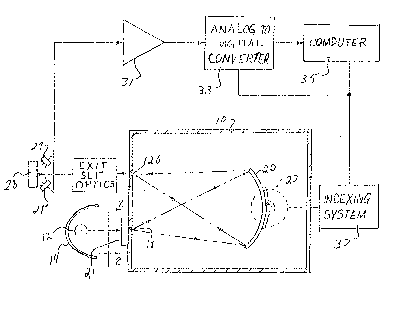Some of the information on this Web page has been provided by external sources. The Government of Canada is not responsible for the accuracy, reliability or currency of the information supplied by external sources. Users wishing to rely upon this information should consult directly with the source of the information. Content provided by external sources is not subject to official languages, privacy and accessibility requirements.
Any discrepancies in the text and image of the Claims and Abstract are due to differing posting times. Text of the Claims and Abstract are posted:
| (12) Patent Application: | (11) CA 2031687 |
|---|---|
| (54) English Title: | SYSTEM TO REDUCE WAVE SHIFT ERROR IN SPECTROPHOTOMETER CAUSED BY HOT SPOTS IN THE LIGHT SOURCE |
| (54) French Title: | SYSTEME POUR REDUIRE LES ERREURS DE DECALAGE DUS AUX POINTS CHAUDS DE LA SOURCE LUMINEUSE DANS UN SPECTROPHOTOMETRE |
| Status: | Deemed Abandoned and Beyond the Period of Reinstatement - Pending Response to Notice of Disregarded Communication |
| (51) International Patent Classification (IPC): |
|
|---|---|
| (72) Inventors : |
|
| (73) Owners : |
|
| (71) Applicants : |
|
| (74) Agent: | MACRAE & CO. |
| (74) Associate agent: | |
| (45) Issued: | |
| (22) Filed Date: | 1990-12-06 |
| (41) Open to Public Inspection: | 1991-06-07 |
| Examination requested: | 1997-09-24 |
| Availability of licence: | N/A |
| Dedicated to the Public: | N/A |
| (25) Language of filing: | English |
| Patent Cooperation Treaty (PCT): | No |
|---|
| (30) Application Priority Data: | ||||||
|---|---|---|---|---|---|---|
|
ABSTRACT OF THE DISCLOSURE
An improved near infrared spectrophotometer is
disclosed which reduces wave shift errors arising from
hot spots in a light source. A ground quartz plate
uniformly diffuses radiation from the light source to
evenly illuminate the entrance slit for a diffraction
grating. Radiation emerges from the entrance slit
with a uniform angular intensity distribution and is
dispersed into a spectrum by a reflecting diffraction
grating towards an exit slit. A narrow wavelength
band of radiation passes through the exit slit to
illuminate a sample. Because the entrance slit is
uniformly illuminated, without regard to variations in
radiation intensity due to hot spots in the source,
wave shift errors in the reflectivity measurements for
the sample are reduced.
Note: Claims are shown in the official language in which they were submitted.
Note: Descriptions are shown in the official language in which they were submitted.

2024-08-01:As part of the Next Generation Patents (NGP) transition, the Canadian Patents Database (CPD) now contains a more detailed Event History, which replicates the Event Log of our new back-office solution.
Please note that "Inactive:" events refers to events no longer in use in our new back-office solution.
For a clearer understanding of the status of the application/patent presented on this page, the site Disclaimer , as well as the definitions for Patent , Event History , Maintenance Fee and Payment History should be consulted.
| Description | Date |
|---|---|
| Inactive: IPC from MCD | 2006-03-11 |
| Application Not Reinstated by Deadline | 2000-12-06 |
| Time Limit for Reversal Expired | 2000-12-06 |
| Deemed Abandoned - Failure to Respond to Maintenance Fee Notice | 1999-12-06 |
| Amendment Received - Voluntary Amendment | 1997-12-17 |
| Letter Sent | 1997-10-24 |
| Inactive: Status info is complete as of Log entry date | 1997-10-20 |
| Inactive: Application prosecuted on TS as of Log entry date | 1997-10-20 |
| Request for Examination Requirements Determined Compliant | 1997-09-24 |
| All Requirements for Examination Determined Compliant | 1997-09-24 |
| Application Published (Open to Public Inspection) | 1991-06-07 |
| Abandonment Date | Reason | Reinstatement Date |
|---|---|---|
| 1999-12-06 |
The last payment was received on 1998-10-06
Note : If the full payment has not been received on or before the date indicated, a further fee may be required which may be one of the following
Patent fees are adjusted on the 1st of January every year. The amounts above are the current amounts if received by December 31 of the current year.
Please refer to the CIPO
Patent Fees
web page to see all current fee amounts.
| Fee Type | Anniversary Year | Due Date | Paid Date |
|---|---|---|---|
| Request for examination - standard | 1997-09-24 | ||
| MF (application, 7th anniv.) - standard | 07 | 1997-12-08 | 1997-12-03 |
| MF (application, 8th anniv.) - standard | 08 | 1998-12-07 | 1998-10-06 |
Note: Records showing the ownership history in alphabetical order.
| Current Owners on Record |
|---|
| NIRSYSTEMS INCORPORATED |
| Past Owners on Record |
|---|
| DAVID E. HONIGS |